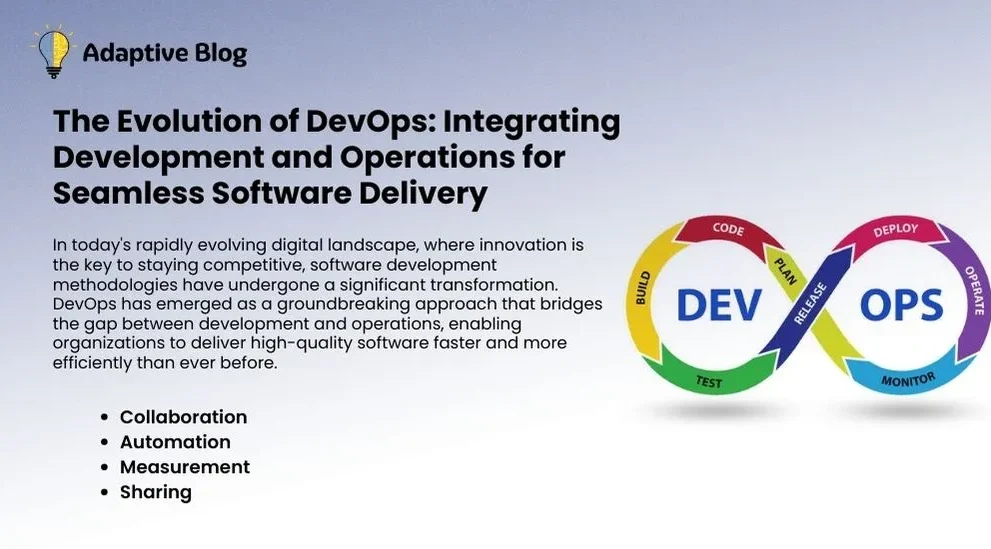The Evolution of DevOps: Integrating Development and Operations for Seamless Software Delivery

In today’s rapidly evolving digital landscape, where innovation is the key to staying competitive, software development methodologies have undergone a significant transformation. DevOps has emerged as a groundbreaking approach that bridges the gap between development and operations, enabling organizations to deliver high-quality software faster and more efficiently than ever before. In this comprehensive exploration of DevOps, we’ll delve into its evolution, core principles, key components, benefits, implementation strategies, and future trends, with a focus on how NNT Digital, a leading software development company, leverages DevOps to drive excellence in their projects.
The Traditional Divide: Development vs. Operations:
Historically, development and operations teams operated in silos, with minimal interaction and collaboration between them. This traditional approach often led to inefficiencies, bottlenecks, and delays in the software delivery process. Developers focused solely on writing code, while operations teams were responsible for deploying and maintaining it. The lack of coordination between these two critical functions hindered the speed, quality, and agility of software development.
Understanding DevOps:
DevOps isn’t merely a set of tools or practices; it’s a cultural and philosophical shift that transforms the way software development and operations teams collaborate, communicate, and work together. At its core, DevOps emphasizes:
Collaboration: DevOps encourages breaking down traditional silos between development, operations, and other cross-functional teams. By fostering open communication and collaboration, DevOps enables teams to work together seamlessly towards shared goals and objectives.
Automation: Automation lies at the heart of DevOps, enabling organizations to automate repetitive tasks, streamline processes, and eliminate manual errors. By automating tasks such as code deployment, testing, and infrastructure provisioning, DevOps accelerates the software delivery pipeline and increases efficiency.
Measurement: DevOps promotes a data-driven approach to software delivery, where metrics and key performance indicators (KPIs) are used to measure the effectiveness of processes and identify areas for improvement. By continuously monitoring performance metrics, teams can make informed decisions and optimize their workflows for better outcomes.
Sharing: DevOps encourages the sharing of knowledge, best practices, and resources across teams and departments. By fostering a culture of sharing, organizations can leverage collective expertise and experience to drive continuous improvement and innovation.
By embracing these core principles, organizations can create a culture of continuous improvement and innovation, where teams are empowered to collaborate, automate repetitive tasks, measure performance, and share knowledge and resources.
Key Components of DevOps:
DevOps comprises several key components that work together to streamline the software delivery process:
Continuous Integration (CI): CI involves the practice of automatically integrating code changes into a shared repository multiple times a day. With CI, developers can detect integration errors early and ensure that the codebase remains stable and deployable at all times.
Continuous Deployment (CD): CD automates the process of deploying code changes to production environments. By automating deployment tasks such as provisioning infrastructure, deploying applications, and running tests, CD enables organizations to release updates rapidly and frequently, with minimal manual intervention.
Infrastructure as Code (IaC): IaC allows organizations to manage and provision infrastructure through code, rather than manual processes. With IaC, infrastructure configurations are defined and managed using code, which improves consistency, scalability, and efficiency, and reduces the risk of configuration drift and manual errors.
Monitoring and Logging: Real-time monitoring and logging provide visibility into the performance and health of applications and infrastructure. By monitoring key metrics and logging events and errors, teams can detect and resolve issues proactively, minimize downtime, and ensure a positive user experience.
These key components form the foundation of DevOps practices, enabling organizations to automate processes, improve collaboration, and deliver high-quality software at speed and scale.
Benefits of DevOps:
The adoption of DevOps brings numerous benefits to organizations of all sizes:
Improved Collaboration: DevOps fosters collaboration and communication between development, operations, and other stakeholders, breaking down silos and fostering a culture of shared responsibility and accountability.
Faster Time to Market: By automating manual processes and reducing cycle times, DevOps enables organizations to deliver software updates to customers more quickly, gaining a competitive edge in the market and responding rapidly to changing customer needs and market demands.
Enhanced Stability and Reliability: DevOps practices, such as automated testing and continuous monitoring, help organizations build more stable and reliable software systems. By detecting and addressing issues early, organizations can minimize downtime, mitigate risks, and ensure a positive user experience.
Implementing DevOps:
Successful implementation of DevOps requires careful planning, execution, and ongoing refinement:
Cultural Shift: DevOps is as much about culture as it is about technology. Organizations must foster a culture of collaboration, transparency, and continuous learning to succeed with DevOps. This cultural shift requires buy-in from leadership, active participation from teams, and a commitment to continuous improvement and innovation.
Toolchain Selection: Choosing the right set of tools is essential for implementing DevOps effectively. Popular DevOps tools include Jenkins, GitLab, Docker, Kubernetes, Terraform, and Prometheus. Organizations must evaluate their requirements, assess the capabilities of different tools, and select a toolchain that aligns with their goals and objectives.
Building CI/CD Pipelines: CI/CD pipelines automate the software delivery process, from code commit to production deployment. Organizations must design, implement, and optimize CI/CD pipelines that suit their development workflows, integrate seamlessly with their toolchain, and enable rapid and reliable software delivery.
Future Trends in DevOps:
As technology continues to evolve, so too does the DevOps landscape. Some emerging trends shaping the future of DevOps include:
Containerization and Microservices: Containerization technologies like Docker and orchestration platforms like Kubernetes are gaining traction for their ability to simplify deployment and scalability.
DevSecOps: With cybersecurity becoming increasingly important, DevSecOps aims to integrate security into the DevOps process, ensuring that security is built into every stage of the software development lifecycle.
Also Read: Elevating Home Comfort: The Benefits of Water Booster Pumps
Conclusion:
DevOps represents a fundamental shift in how organizations approach software development, deployment, and management. By breaking down silos, embracing automation, and fostering collaboration, organizations can achieve seamless software delivery with speed, efficiency, and reliability. As the digital landscape continues to evolve, DevOps will play an increasingly vital role in driving innovation and success. Companies like NNT Digital, with their commitment to excellence and continuous improvement, are leading the way towards a future where software delivery is faster, more efficient, and more reliable than ever before.





